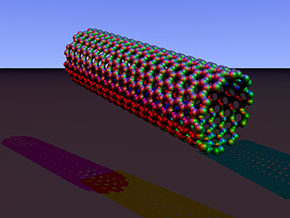

Our knowledge of efficient methods of producing this material of great interest to the microelectronics, optics and other industries is still insufficient, says professor at China’s Tsinghua University (image of carbon nanotube: Wikimedia)
Our knowledge of efficient methods of producing this material of great interest to the microelectronics, optics and other industries is still insufficient, says professor at China’s Tsinghua University.
Our knowledge of efficient methods of producing this material of great interest to the microelectronics, optics and other industries is still insufficient, says professor at China’s Tsinghua University.

Our knowledge of efficient methods of producing this material of great interest to the microelectronics, optics and other industries is still insufficient, says professor at China’s Tsinghua University (image of carbon nanotube: Wikimedia)
By Elton Alisson, in Beijing
Agência FAPESP – Efforts to spread the industrial use of multi-wall carbon nanotubes – a material in nanometric scale (billionths of a meter) having several concentric layers or tubes of graphite – have helped lower their cost from US$45,000 per kilogram in the early 2000s to US$100 per kilogram at the present time.
Such efforts have also boosted production of the material by several hundreds of tons per year and expanded their use to commercial applications such as ion-lithium batteries, the type of rechargeable battery most widely used today in electronic devices.
But the production and use of carbon nanotubes on a scale of millions of tons remains far from a reality, owing to existing challenges related to production, purification, dissemination and commercial application of the material.
Such was the assessment offered by Fei Wei, director of the Beijing Green Chemical Reaction Engineering Laboratory in a lecture he delivered during FAPESP Week Beijing-Brazil, which took place last week in Beijing, China.
“When the price of carbon nanotubes falls to around US$10 per kilogram, it may be possible to use them as conductive components on a scale of millions of tons and replace the conventional carbon black loads used today,” said Fei, who is also a professor at Tsinghua University in China.
According to the researcher, there is still an insufficient basic understanding of efficient growth mechanisms and methods of producing carbon nanotubes, environmental and safety concerns, and models for commercializing the material, and these areas will require further investigation.
“The present-day gap between basic research on carbon nanotubes and industrial development needs to be overcome through multidisciplinary research, in order to facilitate a rapid expansion of the carbon nanotube industry,” Fei pointed out.
Republish
The Agency FAPESP licenses news via Creative Commons (CC-BY-NC-ND) so that they can be republished free of charge and in a simple way by other digital or printed vehicles. Agência FAPESP must be credited as the source of the content being republished and the name of the reporter (if any) must be attributed. Using the HMTL button below allows compliance with these rules, detailed in Digital Republishing Policy FAPESP.





